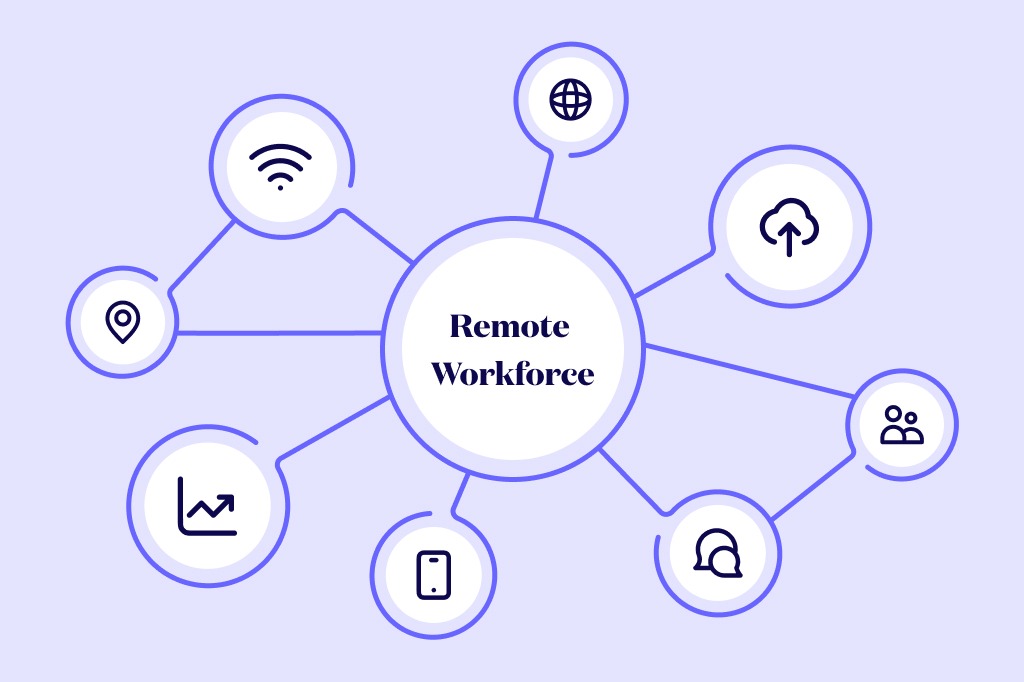The majority of office workers have hybrid work arrangements in place, whether that’s part time office hours, flexitime, remote working, or work from home agreements. To meet the evolving workforce, where it’s increasingly common to have flexible workers, freelancers and consultants on board, technology is becoming a key differentiator.
Fiverr Enterprise is a Freelancer Management System (FMS) that helps businesses to source, hire, manage and pay their flexible freelance workers, all from a single platform.
To understand why remote workforce technology is so important today – keep reading!
This is a series of articles about remote workforce trends.
What Are Remote Workforce Technologies?
Remote workforce technologies are any digital solutions that support employees and freelancers in working from their choice of location. As the number of remote and flexible workers continues to climb, technology can facilitate productivity and communication, and support businesses behind the scenes when dealing with issues such as compliance and payments.
Importance of Technology in Remote Work
Without technology in place, remote work becomes that much more difficult. Think about something as simple as email. If your email client was to go offline, work would take a whole lot longer, and teams would no longer be able to work asynchronously across different time zones or schedules.
Remote workforce technologies build on the example of email and support remote teams in keeping visibility and control over their workload, projects and payments, ensuring the whole workforce is singing from the same hymn sheet, no matter where they work.
Essential Technologies for Remote Work
There are a number of important categories of remote workforce technologies, each of which will be more or less important depending on your specific business context. Here are a few important examples:
- Communication Tools: Communication apps like Slack or MS Teams let distributed workers chat in real-time, and have features such as group chat or channels so that everyone can stay up to date. These tools can also make sure workers don’t feel lonely away from the team.
- Collaboration and Productivity Tools: Technology can help teams to track milestones, projects and budgets, and keep on top of important metrics such as employee satisfaction, productivity and even burnout.
- Project and Task Management Software: Tools such as Monday.com, Trello or ClickUp are now an important part of the office, allowing remote workers to log on from anywhere and view their open tasks and the progress of their projects.
- Time Tracking and Management Tools: If managers are worried about employees working from home, or freelancers are being paid by the hour, time tracking and management tools can add visibility and transparency to remote work.
- Security and VPN Solutions: Remote work opens up a whole lot of risk to company networks, as employees and freelancers use home networks for both work and play. A robust security suite including VPNs and RDP can be a powerful toolset.
Future Trends in Remote Work Technologies
Looking ahead, the growth in the remote workforce is not slowing down any time soon. And for as long as we have remote workers, there will be innovative technology solutions that support its needs.
One trend to look out for is the emergence of AI, and GenAI tools in particular. Business News Daily predicts that AI will take on an increasingly important role in managing remote staff, for example via smart virtual assistants that can anticipate workers’ needs and provide proactive support.
According to LinkedIn research, advanced collaboration tools are another area that’s only just getting started. We can already benefit from “virtual reality meetings for immersive collaboration, AI-driven project management for optimized workflows, cloud-based platforms for real-time document collaboration, unified communication systems integrating various channels, collaborative editing tools, workflow automation, and enterprise social networks.” The opportunities are endless.
Another important element of the workforce to watch is the freelance revolution.
Remote workforce technology enables anyone to work from anywhere, one of the reasons why 1.57B people are already embracing freelance life.
Remote Work Technology to Support the Freelance Revolution
To get the most out of freelance talent, who offer niche expertise at the top of their industries, it’s important that your business also onboards the right workforce technologies. These tools support you in finding the right people for the job, quickly and compliantly onboarding them to your workforce, managing their workload, and paying them accurately and on time.
Fiverr Enterprise is a Freelancer Management System (FMS) that gives you full visibility and control over your entire freelance workforce by allowing you to source, hire, onboard, manage and pay, all while ensuring compliance, so your teams can work faster and maximize business growth. The platform is built from the ground up to facilitate organizations in benefiting from the spike in freelance talent, beating the skills gap and onboarding the best available talent, no matter where they work. With Fiverr Enterprise, you can:
- Find the right talent: Our sourcing experts use your job listing to suggest 2-6 pre-vetted, highly capable candidates in up to 48 hours.
- Ensure 360 degree compliance: From worker classification, to all the right legal and tax documentation – compliance is automated from end-to-end.
- Build your own talent pool: Find freelancers you love, and include those you’ve worked with in the past. Make it quicker to get a project started (and finished).
- Pay on your terms: You pay one invoice to Fiverr Enterprise each month, and every freelancer is paid accurately and on time, according to their requirements.
Schedule 30-mins with one of our workforce experts, and see how Fiverr Enterprise works for yourself.
